
Helen is going on a serious diet. It will be the most careful, obsessive work I’ve done to date, because it’s a finished car that I’m playing with, not a new build. It was to finish the diet every bit as shiny as it starts, if not more so. Moreover, this is about losing weight from places we’ve never bothered with before, and that means a nip and tuck to every single piece I come across. Everything wants to be looked at again. It is such a long process I expect that it will take many months to complete, but it has to be done.
The target weight, including pilot, is 1220kg, which I think is actually impossible within the regulations, which demand retention of the bodyshell in the fullness of its original steel, no alloy boot floor or inner wings like colanders etc. But we’ll give it a go.
The new carrier is made from thick alloy angle, and in a nod to my new obsession, drilled for lightness. Laugh all you like, but the old carrier was over 2kg. The new one is 600g. Well then. The battery is still much larger than some would suggest appropriate for a racing car, but we need the ability to crank a big engine for a long time. If we ever need that last few kilos and we’ve an engine that is on the button every time, then maybe we’ll one day have a tiny thing, but this car is still in development and we prefer to have reserves. As the fuel tank, the battery is positioned to offset the driver. It’s all in the diagonal weights, which some people don’t seem to understand.
We know from experience that you cannot drive the pins out of the rear subframe to get a bottom arm off with the boot floor in. I have to have the boot floor fitted, so a simple idea dawns, cut the relevant section out, invert it, and weld it back in. All still there, but now there is room to do so. Of course the plan doesn’t quite work, and I end up fabricating the new piece, but the overall effect is neat enough. A lot of effort purely for ease of a trackside repair we should never need, but that’s what we do. Not one ounce saved doing this, it’s all for the sake of practicality.
The remade bumper supports the bodykit more firmly, and is spaced out a little further to give me a few more millimetres of protection before the shell takes damage. Why not throw it away altogether? Well, you need some protection. I am more likely to be hit than to hit someone, and I’m getting worried what I’ll do to the balance of the car if I take any more off the back, because the greatest weight saving of all is the replacement of nearly 30kg of boot lid with a fibreglass item. 40kg off the rear without the same at the front is going to upset the handling, a lot. The critical thing will be to lose weight from the very front end of the car to offset it.
And the annoying thing is, that’s the tricky bit. Where am I going to find 30kg or so of sprung weight in the front end of the car?
Alloy fasteners are no use for a stressed piece, but they appear sporadically, fastening in such items as the demister fan, wings, bumpers etc. No point holding a fibreglass panel on with a steel bolt after all, in a collision the panel breaks before the bolt does. If you managed to replace even a couple of dozen nuts throughout the whole car, you make a measurable saving. This time round we are doing this with true obsession. Still not happy even at that, I think with more time I could save another percentage point, but that’s for the mid-season holiday when I’ve had my arse handed to me.
What of the pilot, I hear you ask? A hundred kilos could surely shed ten percent. Correct, and that is being done, but that’s central weight, it doesn’t mess with the balance. Balance is what we need. The quest to lighten the front end of the car must now begin in earnest.
Unloaded, and unaware of what’s about to happen to her.
Boot stripped in two shakes of a lamb's tail. Bit hard on the lamb, but we all make sacrifices.
Modifications were swift. Boot floor inverted section, and 75% of the battery carrier cut away. Tank mounting tabs welded in.
Unexpected failure of the garage lights made it more challenging. There is about a man-week of time spent there!
Filled, primed, and wet sanded. In December. By hand. Without heating. I do sometimes wonder why we do it.
As is traditional by now, I will now report on this as follows: I blue myself.
Got to be comfortable whilst masking up for the stripes. Yes, I'm really about to do what you fear I'm about to do.
Did this primarily because it will make Officer David roll his eyes in dismay, but also because you can't take this game too seriously.
Tank mocked-up in new fabricated bracket. Took bloody ages. Fuel system doesn't change fundamentally from what we've always run.
The new mount for the alloy tank is made from thin steel angle, which is then painstakingly drilled for weight. You can probably buy it pre-perforated, but I didn’t. Two brackets welded in the boot align with the new mounting tabs, whilst a forward brace attaches to the firewall via the 4 existing holes for the rivets that hold on the aluminium plates that seal the firewall. If we can make one item do two jobs we tend to be happier. Making this thing took hours. Lots of them. The tank is mounted to the left, in a vain attempt to balance the driver. The hose to remake the fuel filler neck is horribly expensive though, that costs about half what the damned tank does, and I could only get it in blue, which is a bit ostentatious.
Then a critical eye is cast over the boot. It needs painting, but whilst I’m here, what else can go? Well, the battery carrier was made when this car was 60kg underweight, and built from massive steel angle, and large enough to take a 45 kg lorry battery. Our efforts these days are neater. I cut out the old frame, leaving part of it behind, just in case we ever need to swiftly change battery for something larger. I drilled that frame many, many times, to allow for a vast number of potential bolt holes. You have to plan for it going wrong trackside, needing to fit a battery that’s a bizarre shape or size, and being without power to drill holes. If you have a carrier that can be reconfigured without any messing around life will be easier, and we’ll never have to do it.
There are a few other nips and tucks in the rear end, throwing away some of the brackets for the pump and filter in favour of either direct mounting or a new fabricated item, for example, and a keen eye will spot that I drilled those too, but when complete the losses in the boot are up to 15kg, without compromising the steel of the shell.
The rear bumper is to remain, but remade using box section steel. The old item had received a few helping hands to reshape it over the years, bent and twisted in all known dimensions starting at Mallory Park in 2007 and added to every year I raced in the roadgoing class, the mid-pack goring was often unkind to the rear end, and some of the armour that Helen still sports is a legacy from those days we may need to revisit now.
The boot aperture didn’t get much attention during the last rebuild, but now it has done. Sanded down, by hand, naturally, after the welds have been ground up again, and painted. We specifically painted the white stripes inside the boot because we knew that it would make Officer David call us rude words. We haven’t lost our sense of humour with this racing lark.
Reassembled, with new tank, everything cleaned up, it looks like we meant it. The temptation would be to mess with the fuel system, but there really is no need, the system we’ve been running for five years is proven good enough to support 320bhp, and I don't have 320bhp. Curiously, the fuel consumption at the Birkett was far lower than we expected, we bank on a litre per minute, but Helen did an hour on 40 litres, so is actually somewhat more efficient than we would hope. The McGivern’s solution to this unexpected quandary is that should increase the horsepower so that we drink petrol faster.
.
Moving forwards, the next obvious weight loss is in the doors. No alloy or fibreglass skins allowed here, but I can take out the side impact bars and some of that inner frame. There is an easy 15kg in the doors. The glass can become lexan too, that saves a little. There is a total of 20kg lost here, once I’d replaced the quarter lights with lexan, and that retains the manual winders, because misreading the rules they say I must. There is, therefore, another 5kg I could have trimmed with less restrictive regs, more if I could have machine-gunned the steel frame, and more again if I were allowed to re-skin the door. We got Bear’s down to under 10kg per door, despite retaining a steel frame. The more “historic” approach to the pre-83s holds us back a little, but I’m banking on the improvement still being dramatic.
Whilst shaking off the office party hangover the steering column and dashboard jumped out. The mess of wiring and chaos left behind is best left for another day. What it allows, at last, is removal of the heater. 11kg clatters onto the floor with easy triumph. All the years I ran with the Jags the heater was mandatory, but now it can come out. You still need a demist, however. I have successfully experimented with other cars since this car was built, using single Jaguar blowers to feed the central plenum direct, but now I am going further. I remade the top to the original shape, but in aluminium with a plastic plenum, and fed it with a 4” inline fan, cutting the weight right down to just over a kilogram. The throughput of air is still exactly as it was before, but we lost 10kg, and if it gets hairy I can still put the window down!
An obsessive look at the steering column mountings and various bracketery under there allowed another kilo to go missing, little bits like chopping off the old steering lock barrel. The lock itself went missing years ago, but that last hundred grammes of monkey metal doesn't need to be there, and now it's not. The big knurled steering column adjuster was spun in the lathe to shed more, turned down just to an alloy collar. The overall weight loss behind the dash came to about 12kg. It’s not a bad start. Do that 7 more times and we’re getting somewhere.
The trick is to lighten the car in such a way that we don’t lose the weight balance, and that’s the tough bit, because the easy weight is all at the rear of the car. But, we can lighten it, or make provision for it to be lighter, such that for every future kilo we find at the front, we can take one off the rear. It might not be at its lightest now, but it will be ready for it. Balance beats overall weight if there are any corners.
Weight loss starts in the boot. One clear gain to make here, the fuel tank. Original Jaguar tank torn out, and a 30 litre alloy tank to go in, custom made by a chap we found on Ebay, at most reasonable money. 30 litres seems like precious little, but the maths here says 20 minute races, at a litre per minute, plus 5 laps extra for safety, restarts etc, equals 25 litres, 30 plus the 2 litre swirl pot means we have plenty. It’s about 10kg saved in the tank swap, including the brackets.
The dashboard itself can also stand some time being spent on it. There’s a surprising amount of steel in an XJS dashboard. They are not hugely heavy at 5kg, but when you are wanting to slim down a car that is so far over, every bit you can save is important. The rules say the dash must be present, and in the original material, so no GRP replica here. It can, however, be slimmed down, and with patience and time, 5kg became 4kg. It depends how much of the steel inside the dash you dare cut away. I remade part of the glovebox lid in alloy, which saved half a pound.
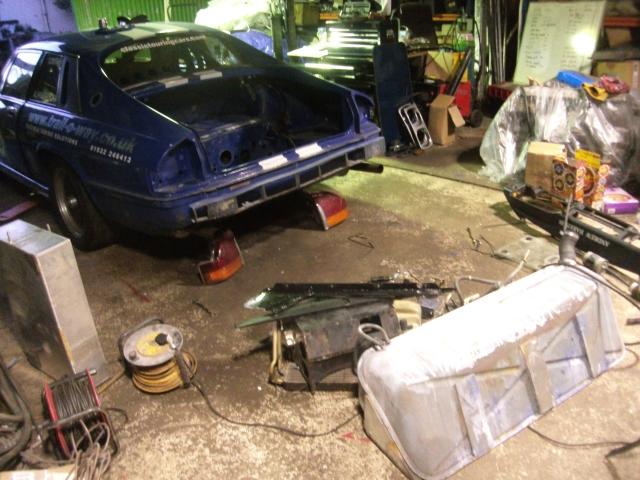
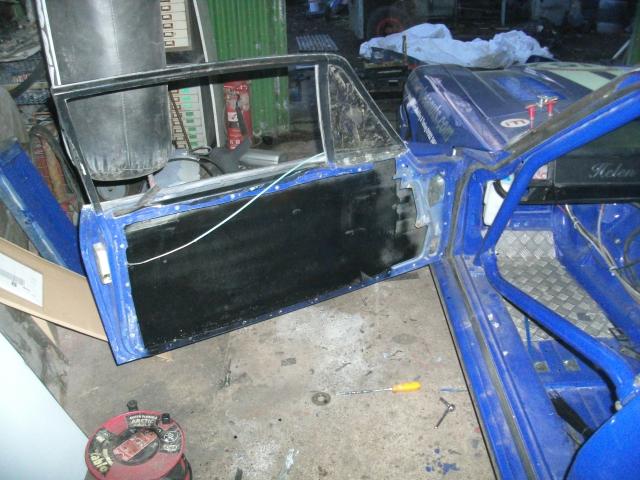
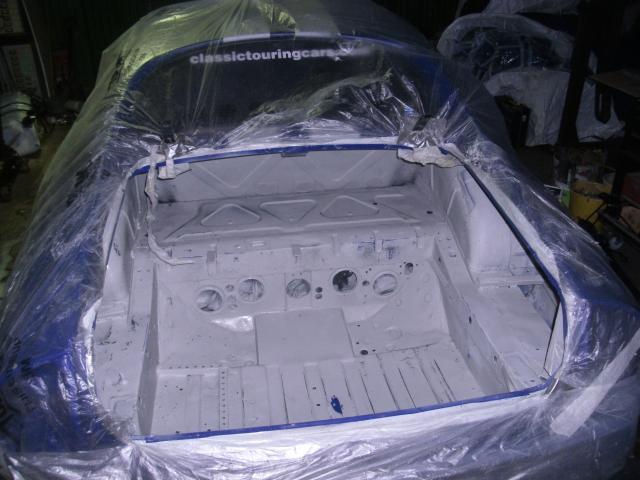
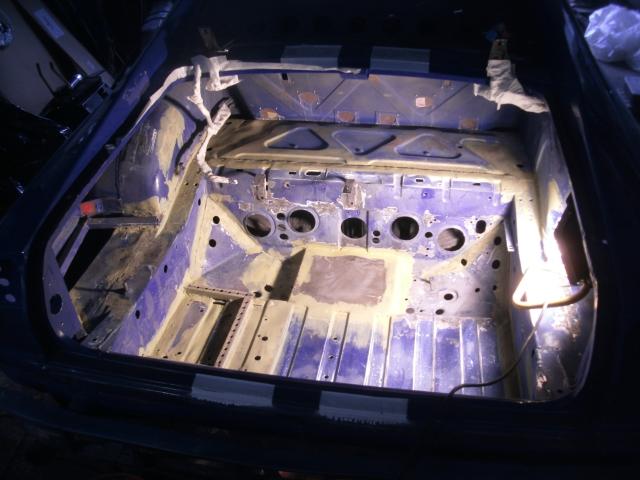
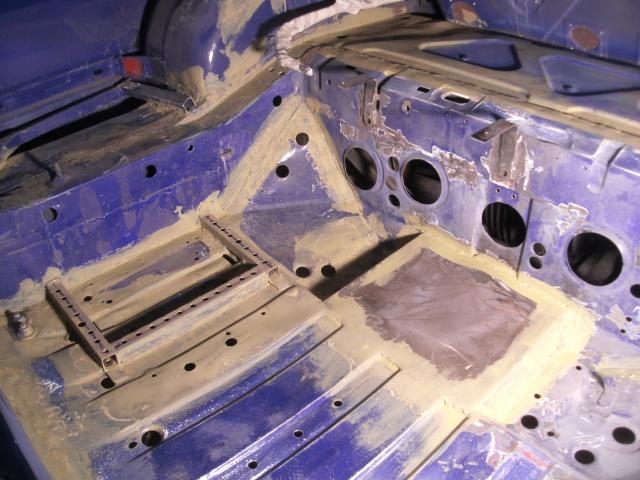
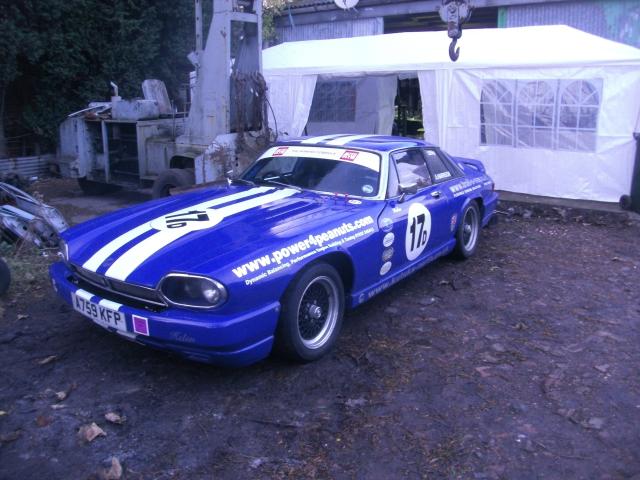
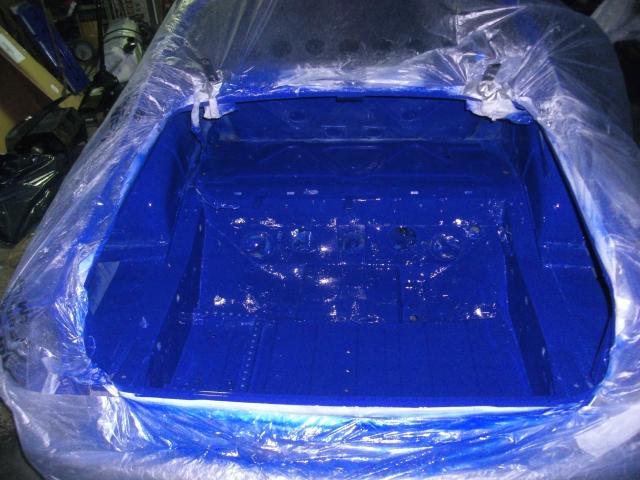
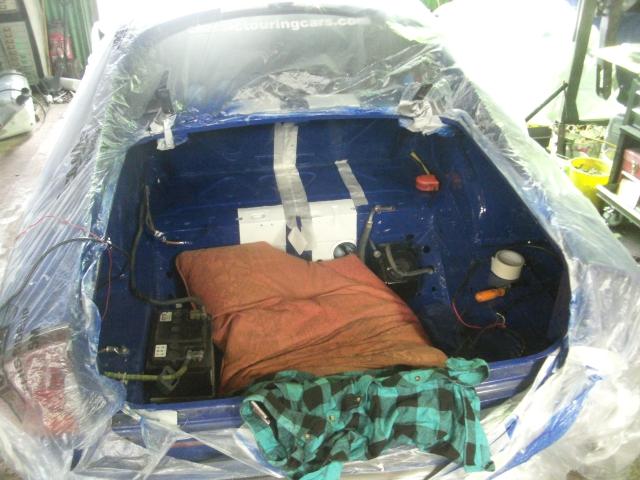
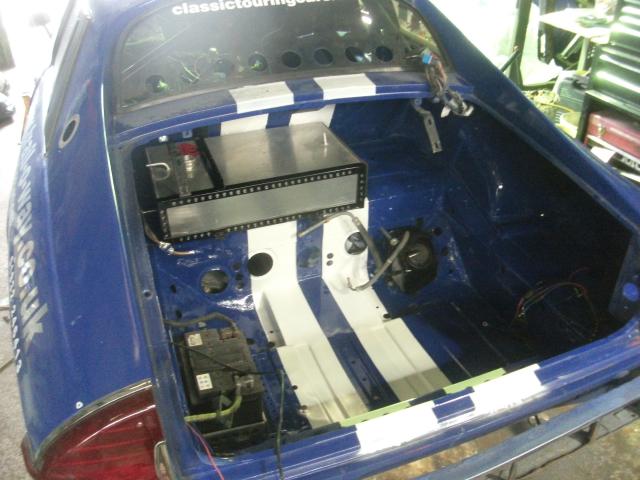
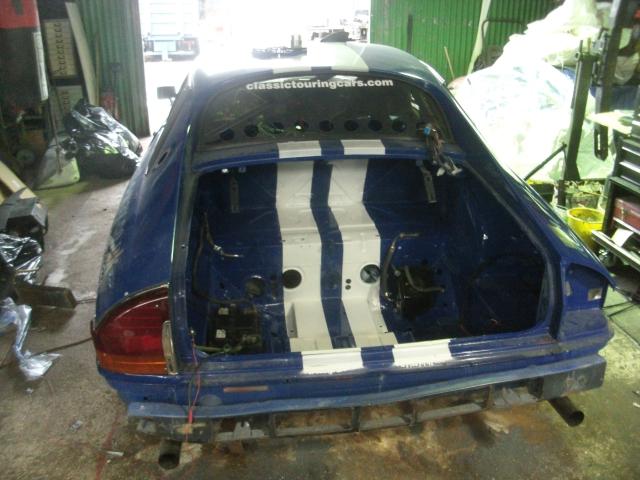
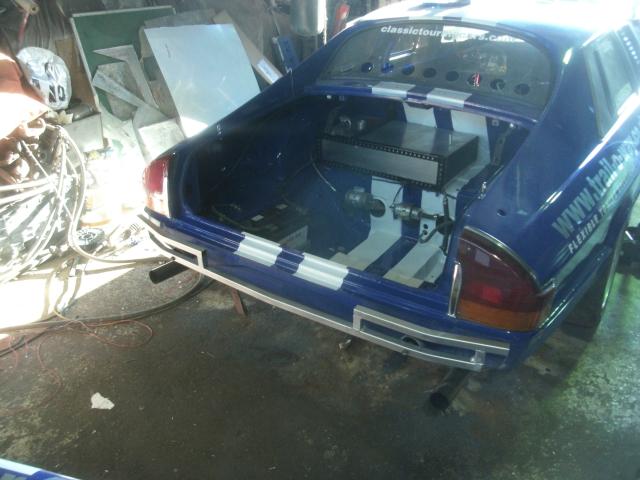
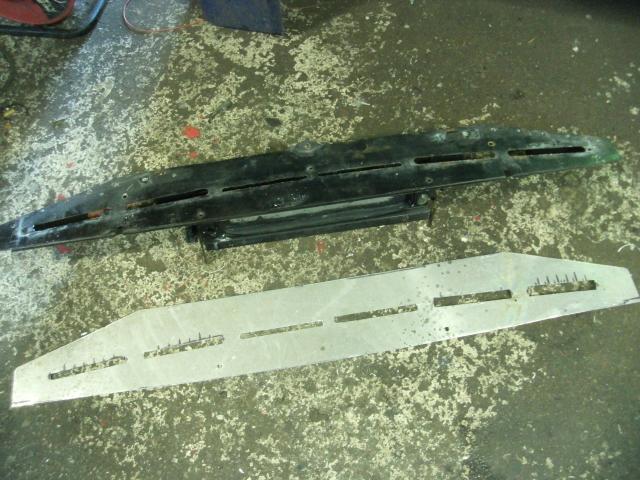
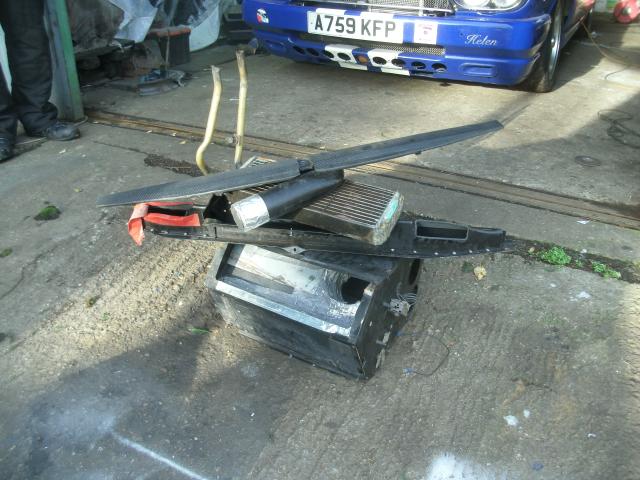
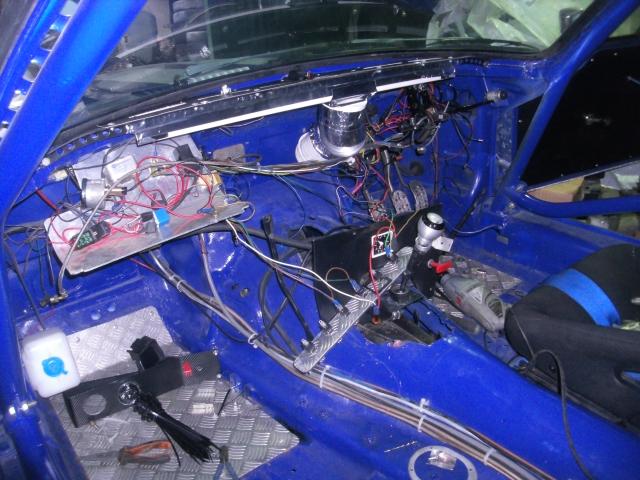
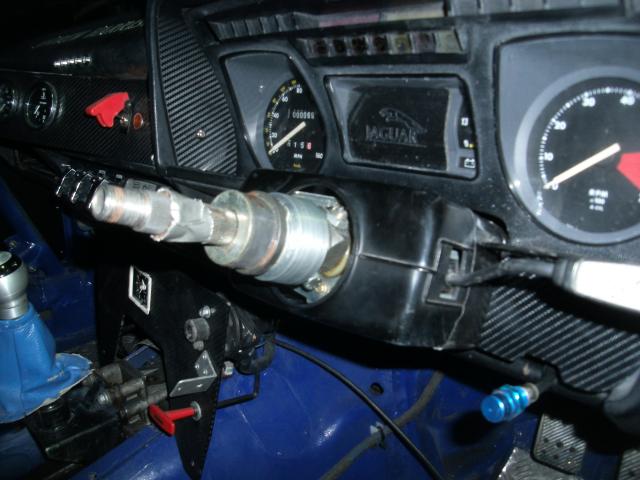
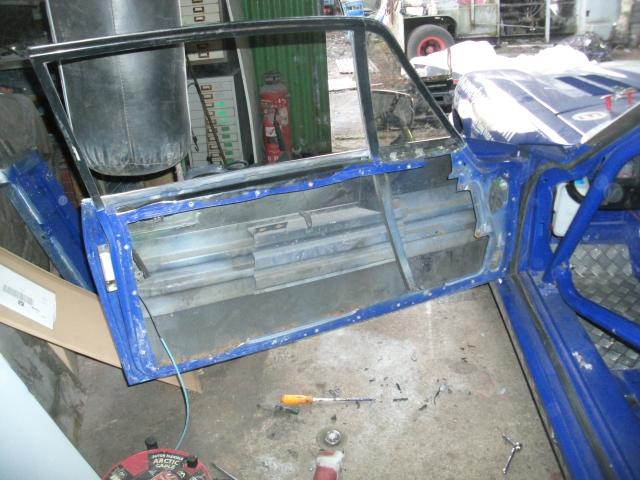
New rear bumper is a little lighter, but still gives Dermott something to bounce on when we set the dampers.
Inner frame removed to allow access to the side instrusion bars.
Quarterlight already remade in tinted lexan.
Bars removed, door de-rusted and painted. Lexan window and mechanical winder to be refitted.
Been carrying this stuff around for 7 years. Always did seem a bit stupid, but regs used to require it. They don't now.
Old demist plenum top v new. 2kg vs 200g. I don't have any fancy equipment, the slots are by hand. The varying sizes are deliberate - priority to the driver's side, bigger slots further away from the central fan in an attempt to equalise airflow.
Demister in situ. Uses he old inline fan, now mounted to the shell, ducted to an ally and plastic plenum, and a whole shed-load of shiny tape. It blows.
Steering column now devoid of that giant adjuster nut, turned down in the lathe to become the smaller alloy nut seen here. Those speedo numbers will never change!
A stripped door often becomes somewhat flimsy, losing the inner skin makes it flop somewhat, and it is often only refitting an inner door card that firms it up. Curiously misreading the regs help here, because the windows must work. That means fitting a mechanical winder, and that has to hang off something, so only part of the inner skin is removed. A piece of aluminium angle adds a vertical stay for the rear, and in the process restored some of the "clunk" to the mandatory door slam test. Don't pretend you don't do it too, everyone who has ever stipped a racing car door has always wafted it back and forth to feel the new weight, then slammed it afterwards to giggle at how tinny the new noise it makes is. That's when I realised the windows don't have to work and the winders can come out, but I'll leave the alloy stay in place, it weighs nothing and it does stiffen the door up.
I stripped the instrument pod to lose the three redundant barrel gauges, we only use the charge indicator. The speedo was thrown out, it didn’t work and for road use a GPS unit is used anyway. For the sake of my amusement, I removed, reset and bonded the trip counter back in, at 15.6, Helen's race number and cylinder count. Am I a bit crackers? Yes. I don't care what you think though, which is nice. That totalled another half kilo. These little bits amount to almost nothing at all, hours of work for almost no weight, but the dash, other than the rollcage, is about the highest point on the car, and cumulatively the little bits do count.
There is a great deal of playing here, but that's because we're trying for something that I don't think has ever really been done before. Nobody plays with the 6 pot XJS to the sort of degree we're after here, there is no bank of knowledge to make a 1220kg pre-83 compliant 6 cylinder XJS. As usual we have set ourselves a tricky challenge. We don't have 100 other guys out there doing this, as if we raced an Escort, or Caterham, or even a BMW, we're in a bit of a niche group, and if that means a lot of messing about learning where we can save the weight, that's how it must be. Bet against us.
All this takes time. Lots of time. There are the little losses here and there that you can’t keep track of. Every nut and bolt I encounter is assessed for whether it can be shorter, or whether it is doing a job that is sufficiently feeble that I can replace it with an aluminium bolt, nut, or washer. I hoovered up a good quantity of alloy nuts etc from Ebay at sufficiently modest cost that even if I threw them away after a single use it wouldn’t be too painful, and cumulatively they do add up.
As the dash goes back in, the unexpected amount of space vacated by the heater allows the wiring to take a more sensible path, and the end result is a little neater. What we're still missing is a brakelight switch, which failed at the Birkett, and replacements for these old units are expensive, and rare. The solution was the proven bodge we adopted with Vanessa, use the later item and a jubilee clip on the pedal. Crude, but effective. At least it won't now look as if we've fitted some sort of dodgy brake light delay, the footage from the other cars at Silverstone looked as if I was playing all sorts of games, but really it was just broken!
Helen is hastily thrown back together at this point, because she has a dinner to go to. The Touring Car club awards dinner has to be attended, and what better, more appropriate way is there to test that new fuel tank than a 200 mile blat there and back? If only I didn't have to fill up with fuel going each way. Whose bright idea was that 30 litre tank?
Once we return, it's time to hunt that 30kg at the front, and then the moment of truth on the scales. I'd better start eating salad.